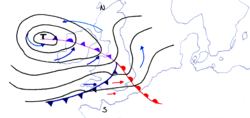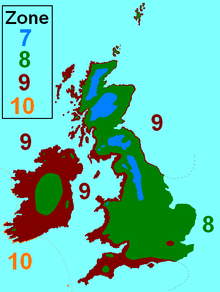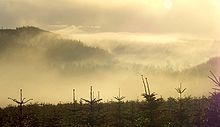+context of location |
LemonMonday (talk | contribs) Undid revision 400009851 by Fmph (talk)Revert per WP:BRD. I don't believe this is true |
||
| Line 1: | Line 1: | ||
[[Image:Wetterkarte mit Okklusion.png|right|thumb|250px|A typical North Atlantic [[low-pressure area]] moving across Ireland.]] |
[[Image:Wetterkarte mit Okklusion.png|right|thumb|250px|A typical North Atlantic [[low-pressure area]] moving across Ireland.]] |
||
The '''climate of [[Ireland]]''' can be summed up as being mild, moist and changeable with abundant [[rainfall]] and a lack of [[temperature extreme]]s. It is defined as a [[temperate]] [[oceanic climate]], or ''Cfb'' on the [[Köppen climate classification]] system |
The '''climate of [[Ireland]]''' can be summed up as being mild, moist and changeable with abundant [[rainfall]] and a lack of [[temperature extreme]]s. It is defined as a [[temperate]] [[oceanic climate]], or ''Cfb'' on the [[Köppen climate classification]] system. The country receives generally warm summers and mild winters, and is considerably warmer than other areas on its [[latitude]]. This is due to the fact it lies in the [[Atlantic Ocean]], and as a result is warmed by the [[Gulf Stream]] all year. [[Met Éireann]] is the meteorological service of the [[Republic of Ireland]], and the [[Met Office]] is that of [[Northern Ireland]]. |
||
==Temperature== |
==Temperature== |
||
Revision as of 21:48, 3 December 2010

The climate of Ireland can be summed up as being mild, moist and changeable with abundant rainfall and a lack of temperature extremes. It is defined as a temperate oceanic climate, or Cfb on the Köppen climate classification system. The country receives generally warm summers and mild winters, and is considerably warmer than other areas on its latitude. This is due to the fact it lies in the Atlantic Ocean, and as a result is warmed by the Gulf Stream all year. Met Éireann is the meteorological service of the Republic of Ireland, and the Met Office is that of Northern Ireland.
Temperature
Ireland, as a whole, experiences a lack of temperature extremes compared to other areas of similar latitudes. Summers are generally warm and winters are mild. There is a regional variation, with inland areas being cooler in winter and warmer in summer than their coastal counterparts.
The warmest areas are found along the south-west coast. Valentia Island, County Kerry has the highest annual mean temperature, at 10.4 °C (50.7 °F).[1]
The coldest areas are found inland. Clones, County Monaghan and Mullingar, County Westmeath both have the lowest annual mean temperature, at 8.8 °C (47.8 °F).[2][3]
The highest temperature ever recorded in Ireland was 33.3 °C (91.9 °F) at Kilkenny Castle, County Kilkenny on 26 June 1887. The lowest temperature was −19.1 °C (−2.4 °F) at Markree Castle, County Sligo on 16 January 1881.[4]
Extreme heat and cold are both rare throughout the country. Summer temperatures exceed 30 °C (86 °F) usually once or twice every decade (2006, 2003, 1995, 1989, 1983, 1976 and 1975 are recent examples), though commonly reach 29 °C (84.2 °F) most summers, while severe freezes occur only occasionally in winter, with temperatures below −5 °C (23 °F) being very uncommon, and temperatures below freezing uncommon in many coastal areas.
Mean daily winter temperatures vary from 4.0 °C (39.2 °F) to 7.6 °C (45.7 °F), and mean daily summer temperatures vary from 12.3 °C (54.1 °F) to 15.7 °C (60.3 °F).
Hardiness zones

Most of Ireland is in hardiness zone 9, with the interior being zone 8 and the south-west coast being in zone 10.
Sunshine

The sunniest months are May and June. During these months sunshine duration averages between 5 and 6½ hours per day over most of the country. The south-east gets the most sunshine, averaging over 7 hours a day in early summer. December is the dullest month with an average daily sunshine ranging from about 1 hour in the north to almost 2 hours in the south-east. Over the year as a whole most areas get an average of between 3¼ and 3¾ hours of sunshine each day. Irish skies are completely covered by cloud roughly half of the time.
The sunniest part of the island is the south-east coast. Rosslare, County Wexford is the sunniest area, and receives on average 4.33 hours of sunshine per day (1,580.45 hours per year).[5]
The dullest, i.e., least sunny, part of the island is in the northern half of the country. Clones, County Monaghan is the dullest area, receiving on average 3.19 hours of sunshine per day (1,164.35 hours per year).[2]
Precipitation
Rainfall is, by far, the most common form of precipitation on the island.[citation needed]
Rainfall

Rainfall is extremely common throughout Ireland, although some parts of the west coast receive over four times as much rain as the east coast. Rainfall in Ireland normally comes from Atlantic frontal systems which travel north-east over the Island, bringing cloud and rain. Most of the eastern half of the country has between 750 and 1,000 mm (29.5 and 39.4 in) of rainfall in the year. Rainfall in the west generally averages between 1,000 and 1,250 mm (39.4 and 49.2 in). In many mountainous districts rainfall exceeds 2,000 mm (78.7 in) per year. The wettest months almost everywhere are December and January. April is the driest month generally, but in many southern parts June is the driest.
The average number of "wet days" (days with more than 1 mm (0.039 in) of rain) ranges from about 150 days a year along the east and south-east coasts, to about 225 days a year in parts of the west.
The wettest weather station is that in Valentia Island, County Kerry, which receives 1,430.1 mm (56.30 in) of rain per year, on average.[1]
The driest weather station is Casement Aerodrome, County Dublin, which receives 711.4 mm (28.01 in) of rain per year, on average.[6]
The weather station with the highest number of "wet days" is Belmullet, County Mayo with 193 days per year,[7] while the station with the lowest number of "wet days" is Dublin Airport, County Dublin with 128 days per year.[8]
Rainfall records
- The driest year recorded in Ireland was 1887, with only 356.6 mm (14.04 in) of rain recorded at Glasnevin, County Dublin.
- The longest drought in Ireland occurred in Limerick between 3 April 1938 and 10 May 1938 (37 days).
- The greatest monthly total was 790.0 mm (31.10 in); recorded at the Comeragh Mountains in October 1996.
- The greatest annual total was 3,964.9 mm (156.10 in); recorded at Ballaghbeena Gap in 1960.
- The greatest hourly total was 97 mm (3.82 in); recorded at Orra Beg, County Antrim, August 1980.
- The greatest daily total was 243.5 mm (9.59 in); recorded at Cloore Lake, County Kerry on 18 September 1993
Snow and sleet

Cold conditions are rare in Ireland with snowfall quite uncommon in the lowlands and on the coast. However, it falls regularly on the hills and mountains in the winter. Snow falls around 2 or 3 times a year on the eastern seaboard, while in the mountainous regions it can fall over 30 days a year. Snow does not normally lie on the ground outside of the winter months of December, January and February. Snowfall is variable, and some winters see no snowfall. The winters of 1962/63, 1981/82 and 2009/2010 saw very heavy snowfall.[9] Drifting can occur with strong winds; this can affect busy routes including the Glenshane Pass[10] which is on the A6 road, the main route between Belfast and Derry. The A1 road connecting the two largest cities in Ireland, Belfast and Dublin, has also suffered similar disruption.[10]
The snowiest weather station is that in Clones, County Monaghan; which receives, on average, 26.9 days of snow and/or sleet per year. Of these, 10.8 days have snow lying at 09:00.[2]
The least snowy weather station is that in Valentia Island, County Kerry; which receives, on average, 5.6 days of snow and/or sleet per year. Of these, 0.8 days have snow lying at 09:00.[1]
Hail
Hail, like snow and sleet, is also rare in Ireland; however it can occur at any time of the year.
Malin Head, County Donegal receives the most hail; with there being 48.4 days per year with hail falling.[11]
Roches Point, County Cork receives the least hail; with there being 8.0 days per year with hail falling.[12]
Thunder
Thunder is most common in Ireland late in summer; though can occur at any time of the year.
Cork Airport, County Cork experiences the least thunder; receiving it 3.7 days per year on average.[13]
Valentia Island, County Kerry experiences the most thunder; receiving it 7.1 days per year on average.[1]
Wind
Generally, the coast tends to be windier than inland areas; and the west tends to be windier than the east.
The station with the highest mean wind speed is Malin Head, County Donegal; averaging at 16.3 kn (30.2 km/h; 18.8 mph). Malin Head also receives the most gale force winds, recording them on average 66.0 days per year.[11]
The station with the lowest mean wind speed is Kilkenny, County Kilkenny; averaging at 6.5 kn (12.0 km/h; 7.5 mph).[14]
The station that records the least amount of gale force winds is that in Birr, County Offaly; recording them on average 1.2 days per year.[15]
The highest wind speed ever recorded in Ireland was 200 km/h (124 mph; 108 kn) at Kilkeel, County Down on 12 January 1974.
Tornadoes are very rare in Ireland, with around less than ten reported every year - mostly in August.[16]
Fog

Fog is more common inland and on higher altitudes; mainly during winter and during the morning at times of high pressure.
The foggiest station is that at Cork Airport, County Cork, which has 99.5 days of fog per year.[13]
The least foggy station is that at Valentia Island, County Kerry, which has 8.9 days of fog per year.[1]
Recent records
Rainfall
| Year | 2009 | 2008 | 2007 | 2006 | 2005 | |||||||||
|---|---|---|---|---|---|---|---|---|---|---|---|---|---|---|
| Highest annual total | 2,175 millimetres (85.6 in) Valentia Observatory, KY |
1,673 millimetres (65.9 in) Valentia Observatory, KY |
1,351 millimetres (53.2 in) Valentia Observatory, KY |
1,761 millimetres (69.3 in) Valentia Observatory, KY |
1,500 millimetres (59 in) Valentia Observatory, KY | |||||||||
| Lowest annual total | 918 millimetres (36.1 in) Dublin Airport, D |
944 millimetres (37.2 in) Dublin Airport, D |
755 millimetres (29.7 in) Rosslare, WX |
678 millimetres (26.7 in) Casement Aerodrome, D |
624 millimetres (24.6 in) Casement Aerodrome, D | |||||||||
| Highest daily rainfall | 51.2 millimetres (2.02 in) Cork Airport, C 19 November |
102.0 millimetres (4.02 in) Bulderrig, MO 13 August |
53.3 millimetres (2.10 in) Phoenix Park, D 22 June |
55.3 millimetres (2.18 in) Valentia Observatory, KY 25 October |
66.3 millimetres (2.61 in) Cork Airport, C 24 July | |||||||||
| Source: Met Éireann | ||||||||||||||
Temperature
| Year | 2009 | 2008 | 2007 | 2006 | 2005 | |||||||||
|---|---|---|---|---|---|---|---|---|---|---|---|---|---|---|
| Highest mean annual temperature | 11.1 °C (52.0 °F) Valentia Observatory, KY |
11.1 °C (52.0 °F) Valentia Observatory, KY |
11.7 °C (53.1 °F) Valentia Observatory, KY |
11.4 °C (52.5 °F) Valentia Observatory, KY and Rosslare, WX |
11.4 °C (52.5 °F) Valentia Observatory, KY | |||||||||
| Lowest mean annual temperature | 8.7 °C (47.7 °F) Knock Airport, MO |
8.7 °C (47.7 °F) Knock Airport, MO |
9.5 °C (49.1 °F) Knock Airport, MO |
9.1 °C (48.4 °F) Knock Airport, MO |
9.1 °C (48.4 °F) Knock Airport, MO | |||||||||
| Highest temperature | 27.5 °C (81.5 °F) Birr, OY 2 June and Claremorris, MO 2 June |
25.2 °C (77.4 °F) Shannon Airport, CE 24 July |
25.9 °C (78.6 °F) Clones, MN 11 June |
32.3 °C (90.1 °F) Elphin, RN 19 July |
29.2 °C (84.6 °F) Kilkenny, KK 11 July, 12 July | |||||||||
| Lowest temperature | −10.0 °C (14.0 °F) Mullingar, WH 25 December |
−7.7 °C (18.1 °F) Casement Aerodrome, D 19 February |
−6.5 °C (20.3 °F) Clones, MN 7 February |
−7.8 °C (18.0 °F) Birr, OY 3 March |
−5.6 °C (21.9 °F) Casement Aerodrome, D 3 March | |||||||||
| Source: Met Éireann | ||||||||||||||
Sunshine
| Year | 2009 | 2008 | 2007 | 2006 | 2005 | |||||||||
|---|---|---|---|---|---|---|---|---|---|---|---|---|---|---|
| Highest annual total | 1,561 hours Dublin Airport, D |
1,512 hours Dublin Airport, D |
1,789 hours Rosslare, WX |
1,710 hours Rosslare, WX |
1,619 hours Rosslare, WX | |||||||||
| Lowest annual total | 1,319 hours Knock Airport, MO |
1,249 hours Birr, OY |
1,330 hours Knock Airport, MO |
1,304 hours Knock Airport, MO |
1,147 hours Birr, OY | |||||||||
| Highest daily sunshine | 16.0 hours Casement Aerodrome, D 24 June |
15.3 hours Malin Head, DL 26 May |
15.6 hours Knock Airport, MO 4 June and Malin Head, DL 6 June |
15.8 hours Malin Head, DL 25 June |
15.6 hours Rosslare, WX 11 July and Dublin Airport, D 11 July | |||||||||
| Source: Met Éireann | ||||||||||||||
Frost

Air frost occurs frequently in the winter, with most areas seeing over 40 days of air frost every year. In northern areas, air frost occurs on average 10.2 days every January, the month in which air frost occurs most frequently.[17] Along the coast, air frost occurs less regularly. In the Sperrins and the Glens of Antrim air frost occurs around 80 days of year.[18] The pattern is similar with ground frost, with on average around 100 days of ground frost in the lowlands and over 140 in the mountains.[19]
Visibility
Visibility is generally very good, because of the proximity of industry to the coast, allowing breezes to disperse any smoke.[9] Mist and fog often occur, as well as coastal fog in the east,[20] but it is generally not long-lasting. However in winter, it can be slow to clear.[9]
See also
References
- ^ a b c d e Met Éireann - Valentia Observatory (30 Year Averages)
- ^ a b c Met Éireann - Clones (30 Year Averages)
- ^ Met Éireann - Mullingar (30 Year Averages)
- ^ Met Éireann - Temperature
- ^ Met Éireann - Rosslare (30 Year Averages)
- ^ Met Éireann - Casement Aerodrome (30 Year Averages)
- ^ Met Éireann - Belmullet (30 Year Averages)
- ^ Met Éireann - Dublin Airport (30 Year Averages)
- ^ a b c "Met Office:Northern Ireland climate". Meteorological Office. Retrieved 17 May 2008.
{{cite web}}: Italic or bold markup not allowed in:|publisher=(help) - ^ a b "Schools hit by severe weather". BBC News. 4 February 2003. Retrieved 17 May 2008.
{{cite web}}: Italic or bold markup not allowed in:|publisher=(help) - ^ a b Met Éireann - Malin Head (30 Year Averages)
- ^ Met Éireann - Roche's Point (30 Year Averages)
- ^ a b Met Éireann - Cork Airport (30 Year Averages)
- ^ Met Éireann - Kilkenny (30 Year Averages)
- ^ Met Éireann - Birr (30 Year Averages)
- ^ BreakingNews.ie - Yesterday’s tornados ‘almost unheard of’
- ^ "N Ireland 1971-2000 averages". Meteorological Office. Retrieved 17 May 2008.
{{cite web}}: Italic or bold markup not allowed in:|publisher=(help) - ^ "Days of Air Frost 1971-2000". Meteorological Office. Retrieved 18 May 2008.
{{cite web}}: Italic or bold markup not allowed in:|publisher=(help) - ^ "Days of Ground Frost 1971-2000". Meteorological Office. Retrieved 18 May 2008.
{{cite web}}: Italic or bold markup not allowed in:|publisher=(help) - ^ "Northern Ireland: Climate". Encyclopædia Britannica. Retrieved 17 May 2008.
{{cite web}}: Italic or bold markup not allowed in:|publisher=(help)
External links